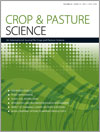
Crop and Pasture Science
Volume 62 Number 12 2011
CP11051 Genotypic diversity in sorghum inbred lines for grain-filling patterns and other related agronomic traits
Sixty-five sorghum inbred lines were evaluated for grain filling and other agronomic traits. Results highlighted the available variability for grain-filling patterns in sorghum, and genotypic differences for all traits were evident. Calculated heritability for grain-filling traits ranged from 0.43 to 0.95, showing grain weight (GW) and maximum water content had the highest values. Grain number showed consistent negative associations with grain growth rate but not with GW due to grain-filling duration variability. This suggests selecting longer grain filling can increase GW without negative trade-off relations with grain number.
CP11180 Selection and characterisation of sugarcane mutants with improved resistance to brown rust obtained by induced mutation
Sugarcane production can be reduced up to 40% by brown rust disease in susceptible varieties. The use of resistant genotypes is the most efficient control method of brown rust; in this regard we obtained five sugarcane brown rust resistant mutants by chemical and physical mutation induction techniques. This work is a contribution to comprehend the genetic bases of brown rust resistance in sugarcane and to the breeding programs in this crop.
CP11165 Effects of nitrogen supply on canopy development of maize and sunflower
The production of biomass under N limiting conditions is a result of the trade-off between allocation of N to leaf area to maintain higher leaf N concentration and thus photosynthesis, and the allocation of N to a large leaf area and thus to increase radiation intercepted. N supply affected the canopy development of maize and sunflower. LAI and SLN in maize and sunflower were reduced under N limitation. However, in general, sunflower tended to maintain SLN and adjust leaf area, whereas maize tended to maintain leaf area and adjust SLN.
CP11136 Agronomic studies on irrigated soybean in southern New South Wales. I. Phenological adaptation of genotypes to sowing date
In the Murrumbidgee Irrigation Area, rice is giving way to other options, particularly intensive double-cropping, to make more profitable use of limited water. Soybean is a potentially useful summer legume for double-cropping, providing that varieties and management can be developed to ensure reliable yields from later than optimal sowings. In this study, hillplot trials were used to model the photothermal responses of a range of variety x sowing date combinations, to narrow down the options that might fit the available double-cropping window.
CP11137 Agronomic studies on irrigated soybean in southern New South Wales. II. Broadening options for sowing date
In double-crop rotations in the Murrumbidgee Irrigation Area, the shorter cropping window after the winter crop reduces soybean yields compared with full-season crops. In the short term, commercially acceptable soybean yields can be obtained from late-sown crops using adapted early-maturing varieties and sound agronomy. However, analyses of the physiological effects of experimental treatments suggest that in the longer term, varieties that are less susceptible to lodging when grown in narrow rows and/or higher density are needed.
CP10158 Agronomic characteristics of annual Trifolium legumes and nutritive values as predicted by near-infrared reflectance (NIR) spectroscopy
Annual legumes are major feed sources for ruminant animals in southern Australia, and their nutritive value is likely to be correlated with agronomic characteristics and chemical composition. Near Infra-Red Scans can potentially be used as a tool to assess the organic composition of various annual legumes across different development stages and temperature regimes. Lignin and xylose contents were shown to influence the digestibility of annual legumes, and NIRS proved to be an accurate, cost-effective, and fast non-destructive tool for routine compositional analysis.
CP11313 Relationship between oil tocopherol concentration and oil weight per grain in several crop species
Tocopherols are essential for humans and a minimum requirement of tocopherol in the diet has been suggested so it is necessary to produce oils with high tocopherol concentration. We demonstrated in the different crop species that the oil tocopherol concentration was lower when the oil accumulated in the grain was higher. These results allow us identifying management practices to obtain grains with oils with greater quantity of tocopherol concentration.
CP11164 Leaf blade nutritional quality of rhodes grass (Chloris gayana) as affected by leaf age and length
Rhodes grass (Chloris gayana) is a tropical species that supports grazing livestock worldwide, but the decline in quality with biomass accumulation greatly affects livestock productivity. This study shows that the digestibility of the leaf fibrous fraction is highly affected by the increase of leaf length during regrowth, in addition to the negative effect of maturity. Controlling pasture height thought grazing or cutting appears as a key and simple trait to improve forage quality and livestock performance in Rhodes grass.



